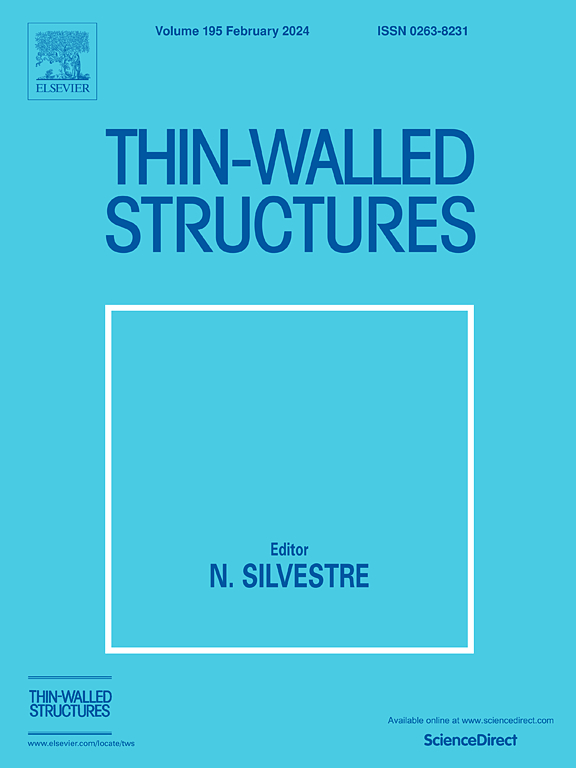Thermal performance analysis and optimization of air-supported membrane building envelope based on numerical simulation
IF 5.7
1区 工程技术
Q1 ENGINEERING, CIVIL
引用次数: 0
Abstract
Air-supported membrane (ASM) envelopes offer an effective solution for creating large interior spaces for buildings with lower energy consumption and carbon emissions. However, there is little research on the thermal performance of ASM envelopes, particularly regarding the natural convection within the air interlayer and its impact on thermal resistance. To address this gap, this study developed a numerical model of ASM envelopes and validated it through experiments. Subsequently, a numerical investigation was conducted to analyze natural convection and thermal resistance while considering factors such as indoor-outdoor temperature difference, membrane emissivity and air interlayer thickness. Results indicated that with the emissivity increased from 0.2 to 1, the thermal resistance of the air interlayer and the envelope decreased by 32.35 % and 9.13 %, respectively. Besides, the thickness of air interlayer also had evident effect on thermal resistance. When it increased from 5 mm to 35 mm, the thermal resistance of the air interlayer and the envelope increased by 156.19 % and 14.74 %, and further results in the heat transfer decreased by 13.85 %. However, the convective heat transfer would remain constant when the thickness exceeded 35 mm. This study provided valuable reference for optimizing the design of ASM envelopes and accurately calculating their thermal resistance.
基于数值模拟的空气支撑膜建筑围护结构的热性能分析与优化
空气支撑膜(ASM)围护结构提供了一种有效的解决方案,可以为建筑物创造大面积的内部空间,同时降低能耗和碳排放。然而,有关 ASM 围护结构热性能的研究很少,尤其是关于空气夹层内的自然对流及其对热阻的影响。针对这一空白,本研究开发了 ASM 围护结构的数值模型,并通过实验进行了验证。随后,在考虑室内外温差、薄膜发射率和空气夹层厚度等因素的同时,对自然对流和热阻进行了数值研究分析。结果表明,当发射率从 0.2 提高到 1 时,空气夹层和围护结构的热阻分别降低了 32.35% 和 9.13%。此外,空气夹层的厚度对热阻也有明显影响。当其厚度从 5 毫米增加到 35 毫米时,空气夹层和围护结构的热阻分别增加了 156.19 % 和 14.74 %,并进一步导致传热量减少了 13.85 %。然而,当厚度超过 35 毫米时,对流传热保持不变。这项研究为优化 ASM 围护结构的设计和精确计算其热阻提供了宝贵的参考。
本文章由计算机程序翻译,如有差异,请以英文原文为准。
求助全文
约1分钟内获得全文
求助全文
来源期刊

Thin-Walled Structures
工程技术-工程:土木
CiteScore
9.60
自引率
20.30%
发文量
801
审稿时长
66 days
期刊介绍:
Thin-walled structures comprises an important and growing proportion of engineering construction with areas of application becoming increasingly diverse, ranging from aircraft, bridges, ships and oil rigs to storage vessels, industrial buildings and warehouses.
Many factors, including cost and weight economy, new materials and processes and the growth of powerful methods of analysis have contributed to this growth, and led to the need for a journal which concentrates specifically on structures in which problems arise due to the thinness of the walls. This field includes cold– formed sections, plate and shell structures, reinforced plastics structures and aluminium structures, and is of importance in many branches of engineering.
The primary criterion for consideration of papers in Thin–Walled Structures is that they must be concerned with thin–walled structures or the basic problems inherent in thin–walled structures. Provided this criterion is satisfied no restriction is placed on the type of construction, material or field of application. Papers on theory, experiment, design, etc., are published and it is expected that many papers will contain aspects of all three.
 求助内容:
求助内容: 应助结果提醒方式:
应助结果提醒方式:


